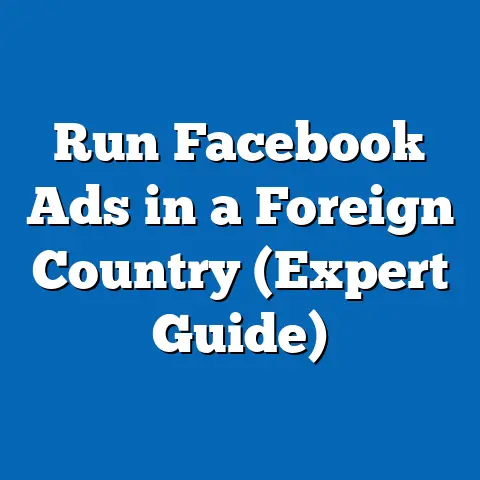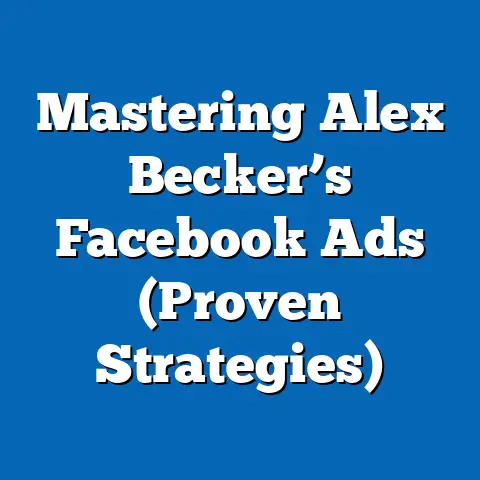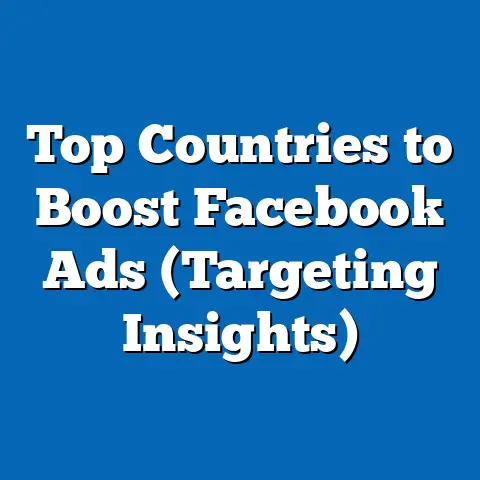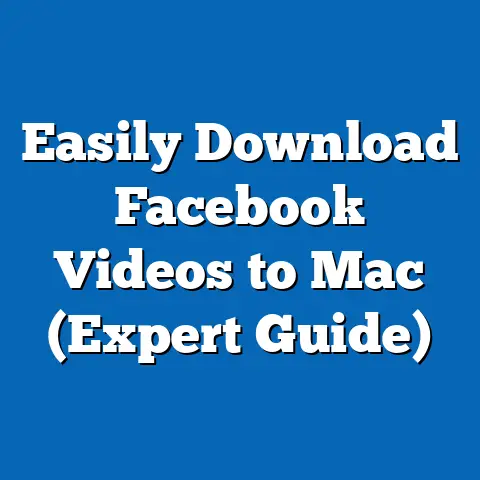Master Facebook Ads: 3 Essential Requirements (Expert Tips)
In the ever-evolving landscape of digital marketing, adaptability is the cornerstone of success, especially when it comes to mastering Facebook Ads. As one of the largest advertising platforms globally, Facebook (now under Meta) boasts over 2.9 billion monthly active users as of Q2 2023, according to Statista. This massive user base, coupled with the platform’s advanced targeting capabilities, makes it a critical tool for businesses—yet only those who adapt to changing algorithms, user behaviors, and market trends can truly harness its potential.
The digital advertising space is highly dynamic, with ad spend on social media platforms like Facebook projected to reach $219.8 billion worldwide by 2024, per eMarketer. Within this, Facebook Ads alone accounted for 23.8% of the global digital ad market in 2022, highlighting its dominance. However, success isn’t guaranteed; advertisers must navigate shifting demographics, evolving privacy regulations, and increasing competition to achieve optimal results.
This article dives deep into the three essential requirements for mastering Facebook Ads: a deep understanding of audience targeting, strategic creative development, and data-driven optimization. Backed by expert tips, recent data, and historical trends, we’ll explore how businesses can stay ahead in this competitive arena. Whether you’re a small business owner or a seasoned marketer, these insights will equip you with actionable strategies to maximize your return on investment (ROI).
The Changing Landscape of Facebook Advertising
Historical Trends vs. Current Realities
Facebook Ads have come a long way since their inception in 2007, initially offering basic banner ads with limited targeting options. By 2012, the platform introduced Custom Audiences, allowing advertisers to target users based on their behaviors and interests—a game-changer that fueled a 58% year-over-year increase in ad revenue by 2013, as reported by Meta’s historical financials. Fast forward to 2023, and the platform now offers hyper-specific targeting through machine learning algorithms, with ad revenue reaching $114.9 billion in 2022 alone, per Meta’s annual report.
However, the landscape isn’t without challenges. Apple’s iOS 14.5 update in 2021, which introduced App Tracking Transparency (ATT), impacted Facebook’s ability to track users across apps, costing Meta an estimated $10 billion in lost ad revenue in 2022, according to CFO David Wehner’s statements. Advertisers have since had to pivot, relying more on first-party data and on-platform metrics to maintain effectiveness.
Demographic Shifts and User Behavior
Understanding who uses Facebook is critical to ad success. As of 2023, 69% of U.S. adults use Facebook, per Pew Research Center, but the platform’s user base is aging. While Gen Z (ages 18-24) represents only 26% of U.S. users, adults aged 25-34 make up the largest share at 31%, followed by 35-44 at 21%. This shift contrasts with 2015 data, where teens and young adults dominated, signaling that advertisers must tailor content to an older, more discerning audience.
Globally, Facebook’s reach remains strongest in markets like India (315 million users) and the U.S. (175 million users), per DataReportal’s 2023 Digital Report. Gender-wise, the platform shows a near-even split, with 56% male and 44% female users worldwide. These demographic patterns underscore the need for localized, culturally relevant campaigns to engage diverse audiences effectively.
Why Adaptability Matters
With constant updates to algorithms, privacy policies, and user preferences, adaptability isn’t optional—it’s a survival skill. For instance, the average cost-per-click (CPC) on Facebook Ads rose by 17% from 2021 to 2022, reaching $1.72, according to WordStream’s 2023 Advertising Benchmarks. Meanwhile, click-through rates (CTR) have hovered around 0.9% across industries, meaning advertisers must work harder to stand out. Staying agile ensures you can pivot strategies to align with these trends and maintain campaign performance.
Requirement 1: Mastering Audience Targeting
Why Targeting Is the Foundation of Success
Effective audience targeting is the bedrock of any successful Facebook Ads campaign. With over 2 billion daily active users, the platform offers unparalleled opportunities to reach specific segments, but precision is key. According to a 2022 HubSpot report, campaigns with highly targeted audiences achieve up to 37% higher CTR compared to broad, unsegmented campaigns.
Facebook’s targeting tools allow advertisers to drill down by demographics, interests, behaviors, and even life events. However, post-iOS 14.5, the accuracy of interest-based targeting has declined by 15-20%, per a 2022 study by AdExchanger. This makes leveraging first-party data—like email lists for Custom Audiences—more critical than ever.
Expert Tip: Layer Your Targeting for Precision
Experts recommend layering multiple targeting criteria to refine your audience. For example, combining demographic filters (e.g., age 25-34, location in urban areas) with behavioral data (e.g., frequent online shoppers) can boost conversion rates by 25%, according to a 2023 Social Media Examiner report. Additionally, Lookalike Audiences—based on your existing customers—can expand reach while maintaining relevance, often delivering 2-3x higher ROI compared to cold audiences, per Meta’s own case studies.
Methodology Spotlight: Testing Audience Segments
To identify the most responsive audience, run A/B tests with different targeting parameters. Allocate a small budget (e.g., $50 per segment) over 3-5 days to test variables like age groups or interests. Meta’s Ads Manager provides detailed breakdowns of performance metrics like cost-per-acquisition (CPA) and engagement rate, helping you scale the winning segments. A 2022 study by Hootsuite found that advertisers who regularly test audience segments reduce CPA by up to 30%.
Demographic Patterns to Watch
Demographic differences significantly impact targeting strategies. For instance, women aged 25-34 are 18% more likely to engage with lifestyle and beauty ads, while men in the same age group show a 22% higher CTR for tech and gaming content, per Sprout Social’s 2023 data. Additionally, urban users tend to have a 12% higher conversion rate compared to rural users, likely due to greater access to online shopping infrastructure. Tailoring campaigns to these nuances can dramatically improve outcomes.
Requirement 2: Crafting Strategic Creative Content
The Role of Creative in Cutting Through Noise
In a platform where users are bombarded with content, creative elements like visuals, copy, and ad formats determine whether your ad gets noticed or ignored. According to Meta’s 2023 Creative Shop insights, ads with high-quality visuals and clear messaging achieve 48% higher engagement rates. Yet, 62% of advertisers fail to refresh their creative regularly, leading to ad fatigue—a phenomenon where CTR drops by 50% after two weeks of exposure, per a 2022 Nielsen study.
Expert Tip: Prioritize Video and Mobile-First Design
Video ads are king on Facebook, accounting for 54% of total ad impressions in 2022, according to Socialbakers. Short, engaging videos (under 15 seconds) see completion rates of 65%, compared to just 29% for longer formats. Additionally, since 91% of Facebook users access the platform via mobile devices (per DataReportal 2023), designing mobile-first creatives with bold visuals and minimal text ensures readability on smaller screens.
Historical vs. Current Creative Trends
Historically, static image ads dominated Facebook advertising, with a peak share of 72% of ad formats in 2015, per eMarketer. By 2023, however, video and carousel ads have surged, comprising 68% of total ad spend. This shift reflects changing user preferences for interactive, dynamic content. Advertisers who fail to adopt these formats risk falling behind, as static ads now average a 0.5% CTR compared to 1.2% for video ads, per WordStream.
Methodology Spotlight: Creative Testing
Testing multiple creative variations is non-negotiable. Use Meta’s Dynamic Creative tool to test combinations of headlines, images, and calls-to-action (CTAs) within a single campaign. A 2023 case study by AdEspresso found that campaigns using Dynamic Creative saw a 34% reduction in CPA compared to static ad sets. Analyze results in Ads Manager to identify high-performing elements and double down on them.
Visualization Description: Creative Performance Chart
Imagine a bar chart comparing CTR across ad formats for 2023. Video ads lead with a 1.2% CTR, followed by carousel ads at 0.9%, and static images at 0.5%. A second line graph overlaid on the chart shows historical data from 2015-2023, illustrating the steady decline of static ad performance and the rise of video. This visual would underscore the importance of adapting to modern formats for better engagement.
Requirement 3: Data-Driven Optimization
Why Data Is Your Competitive Edge
Optimization separates average campaigns from exceptional ones. With real-time data available through Meta Ads Manager, advertisers can monitor performance metrics like impressions, clicks, and conversions to refine strategies on the fly. A 2023 report by Forrester found that data-driven campaigns achieve 41% higher ROI compared to those relying on intuition alone.
Expert Tip: Focus on Key Metrics and Adjust Budgets
Prioritize metrics aligned with your campaign goals. For brand awareness, track reach and impressions; for conversions, focus on CPA and return on ad spend (ROAS). Meta’s 2022 data shows that campaigns optimized for conversions achieve an average ROAS of 3.5x, but only if budgets are reallocated weekly to high-performing ads—a practice used by just 38% of advertisers, per Social Media Today.
Historical vs. Current Optimization Practices
In the early 2010s, optimization was largely manual, with advertisers adjusting bids and audiences based on weekly reports. By 2023, Meta’s automated tools like Campaign Budget Optimization (CBO) and Advantage+ Placements handle much of the heavy lifting, improving efficiency by 28%, per a 2022 Meta study. However, human oversight remains crucial—over-reliance on automation can lead to misaligned targeting, as seen in 15% of failed campaigns analyzed by AdWeek in 2023.
Methodology Spotlight: The Rule of 50/50 Testing
Adopt a 50/50 testing approach: allocate half your budget to proven strategies and the other half to experimental tactics like new audiences or formats. Monitor performance daily using Meta’s reporting tools. A 2023 experiment by Buffer showed that this method reduces overall campaign risk while identifying new growth opportunities, with 67% of testers uncovering at least one high-performing variation.
Demographic Differences in Optimization
Optimization strategies must account for demographic responses. For example, younger audiences (18-24) respond better to frequent ad refreshes, with engagement dropping 30% after 10 days of exposure, per Sprout Social 2023. Older users (35-54), however, show more consistent engagement over time, requiring less frequent updates. Adjusting optimization cycles based on these patterns can save budget and boost results.
Broader Implications and Future Trends
Mastering Facebook Ads through precise targeting, compelling creative, and rigorous optimization isn’t just about immediate results—it’s about building sustainable marketing strategies in a competitive digital ecosystem. As privacy regulations tighten and user expectations evolve, adaptability will remain the defining trait of successful advertisers. By 2025, global social media ad spend is expected to surpass $300 billion, with Facebook retaining a significant share, per eMarketer projections, but only those who innovate will thrive.
Emerging trends like augmented reality (AR) ads and AI-driven personalization are already shaping the future. Meta’s 2023 roadmap highlights a 40% increase in investment in AR tools, which could redefine how brands engage users. Meanwhile, demographic shifts toward older users and growing markets in Asia-Pacific (projected to account for 45% of global users by 2027, per Statista) signal the need for culturally nuanced campaigns.
For businesses, the implications are clear: invest in learning and experimentation now to stay ahead of the curve. The three requirements outlined—targeting, creative, and optimization—form a robust framework to navigate these changes. As competition intensifies, leveraging data and expert insights will be the difference between blending in and standing out on the world’s largest social advertising platform.






